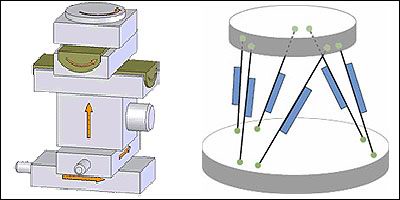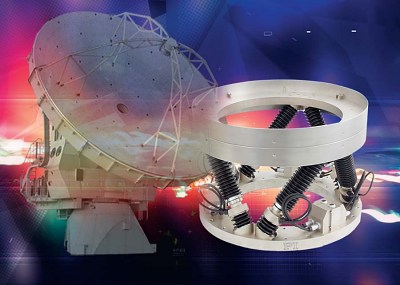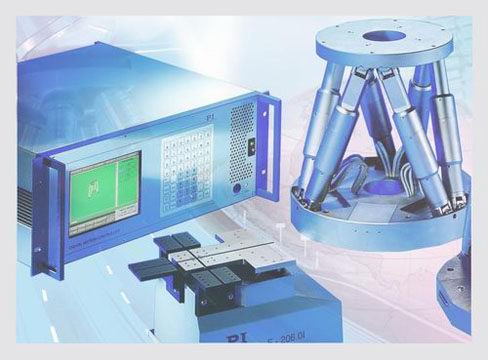| Parallel Kinematics / Stewart Platforms Overview |
 Home << Previous Next >> Home << Previous Next >> |
| Parallel kinematic positioners have many advantages over serial kinematics stacks of stages. Examples are low inertia, higher dynamics, large central aperture, higher stiffness/mass ratio, smaller footprint etc.
Physik Instrumente has more than two decades of experience with design and manufacture of high precision electro-mechanical Hexapods. Commercial products are available in many variations for load capacity from 2 kg to more than 1000 kg. They are the most advanced multiaxis precision positioning systems in the world, providing significantly higher precision than hydraulic hexapods. |  6-Axis Stack of stages (serial) vs. parallel kinematics (Hexapod) positioner. Obvious advantages are: smaller size, reduced moving mass(one common platform), no friction due to moving cables increases reliability and repeatability |

| Hexapods in Astronomy | ||
 Hexapods are ideal positioners for optics and radio telescope anntennas. The Atacama Large Millimeter/submillimeter Array in the Atacama desert in Chile will consist of 64 individual telescopes interconnected to form an enormous antenna. The secondary reflectors of all telescopes need to be aligned precisely for that purpose and the PI designed hexapods can position loads of up to 75 kg with sub-micrometer resolution even in adverse conditions (photo: Vertex Antennentechnik GmbH) | PI is the leading manufacturer of Hexapod high-performance micro- and nanopositioning systems. These parallel-kinematics
devices, in a number of different forms, are suitable for diverse applications, ranging from handling systems in electronics fabrication and tool control in precision machining, through medical technology, to optical systems like those found in space telescopes and satellite receiving antennas.
Various models of the powerful parallel kinematic machines (PKM) can move masses of 50, 200 or even 1000 kilograms with micron accuracy as required in their respective applications. These Hexapod systems are all built with six, high-resolution electro-mechanical or piezoelectric actuators connected to a
common platform, similar to flight simulators, yet considerably more precise: in place of hydraulic cylinders, the Hexapods are driven by highly accurate, precision-controlled rotary or linear motors. Different drive principles are employed, depending on the application: Hexapods with piezomotor drives make for a positioning system which is not only vacuum compatible but also completely non-magnetic.
| |
|
Hexapod Links: Applications in Astronomy and Aerospace
| ||
| Motion Controllers for Hexapod Systems | ||
 | All PI Hexapod systems have a choice of several a sophisticated, yet easy to use motion controller options. The Hexapod controller allows the user to set a pivot point anywhere inside or outside the Hexapod working space, by a simple software command. This randomized pivot point stays with the platform, no matter how it moves—an invaluable feature for example in optics applications. Moves are specified in Cartesian coordinates and the PC-based controller transforms them into the required motion-vectors for the individual actuator drives. The latest controller generation features flexible interfaces: TCP/IP, for remote / network / Internet addressing or highspeed RS-232. | |
 Home << Previous Next >> Home << Previous Next >> |